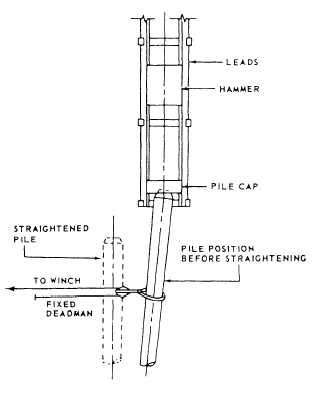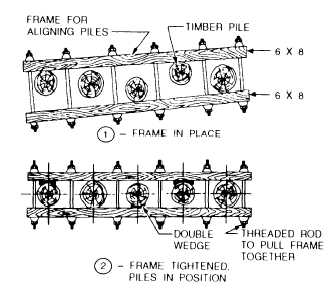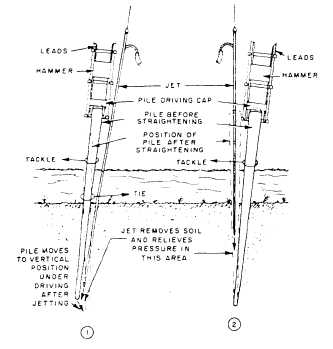an extra dense layer of soil at the tip is called an
end-bearing pile.
A pile supported partly by skin
friction and partly by a substratum of extra dense soil at
the tip is called a combination end-bearing and
friction pile.
It is not always necessary to drive a friction pile to
refusal; such a pile needs to be driven only to the depth
where friction develops the required load-bearing
capacity.
Straightening and Aligning Piles
Piles should be straightened when any misalign-
ment is noticed during pile driving. The accuracy of
alignment that should be sought for the finished job
depends on various factors, but if a pile is more than a
few inches out of its plumb line, an effort should be made
to true it up. The greater the penetration along the wrong
alignment, the harder it is to get the pile back to plumb.
One method of alignment is to use pull from a block
and tackle (fig. 12-70) with the impact of the hammer
jarring the pile back into line. The straightening of steel
bearing piles must include twisting of the individual
piles to bring the webs of the piles parallel to the center
line of the bent.
Figure 12-70.-Realigning pile using block and tackle.
Another method of alignment is to use a jet (fig. 12-71),
either alone or jointly, with the block-and-tackle method
When all piles in a bent have been driven, they may
be pulled into proper spacing and alignment with block
and tackle and an aligning frame, as shown in figures
12-72 and 12-73.
Pulling Files
A pile that has met an obstruction, that has been
driven in the wrong place, that has split or broken in
Figure 12-71.—Realigning pile by jetting.
Figure 12-72.—Aligning frame used for timber pile bent.
12-50






